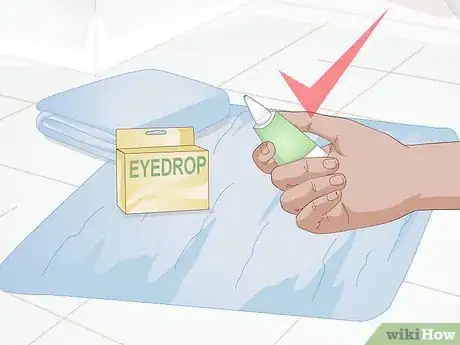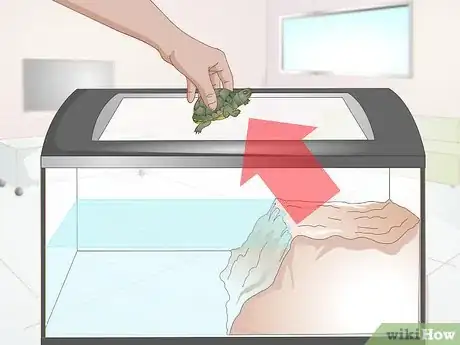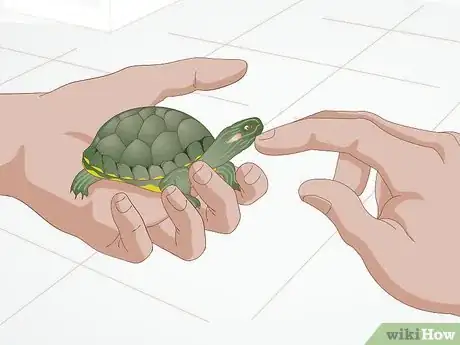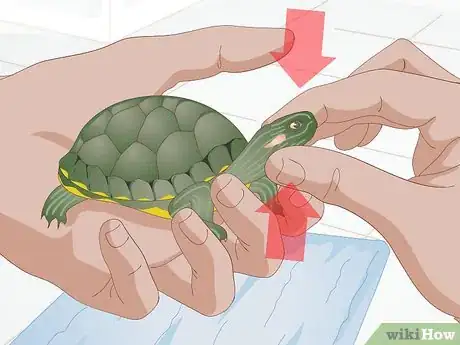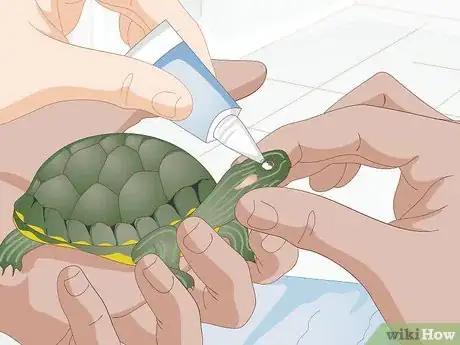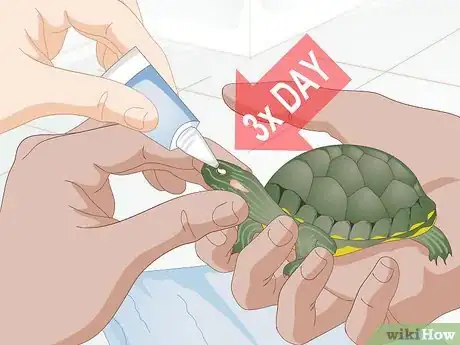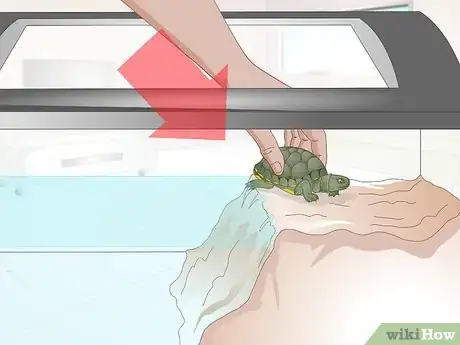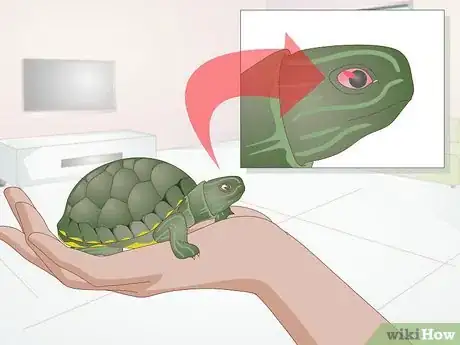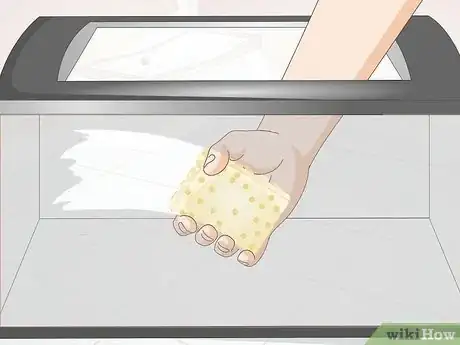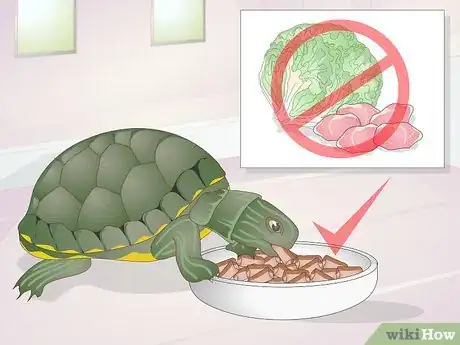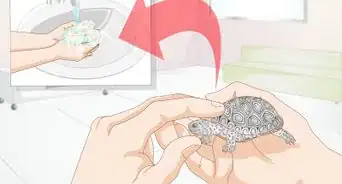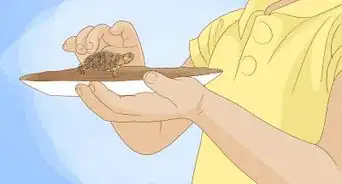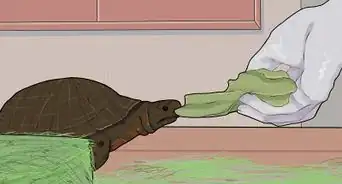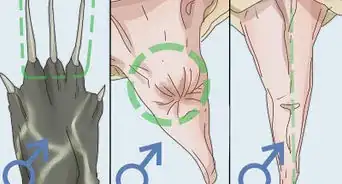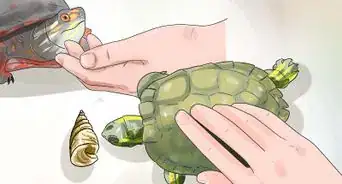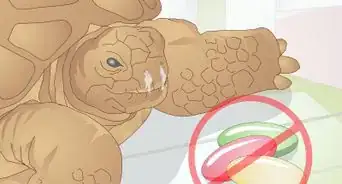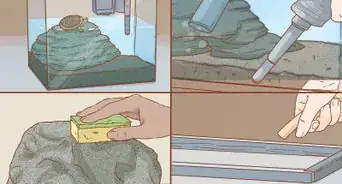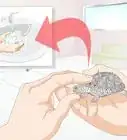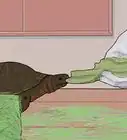This article was co-authored by Pippa Elliott, MRCVS. Dr. Elliott, BVMS, MRCVS is a veterinarian with over 30 years of experience in veterinary surgery and companion animal practice. She graduated from the University of Glasgow in 1987 with a degree in veterinary medicine and surgery. She has worked at the same animal clinic in her hometown for over 20 years.
There are 8 references cited in this article, which can be found at the bottom of the page.
This article has been viewed 98,257 times.
Turtles are great pets. They’re cute and are easy to care for and manage most of the time. However, turtles are susceptible to a number of illnesses that make caring for them more difficult. One of these is eye infections. Unfortunately, it is very difficult to treat a turtle with an eye infection, because of their sharp beaks and claws, and obviously their shells. However, with a little work, know-how, and determination, you’ll be able to apply medicine to your turtle’s eyes so he or she will be on the road to recovery in no time!
Steps
Preparing to Apply Medicine to Your Turtle
-
1Gather supplies and pick a spot. The first step in applying medicine to your turtle’s eye is to gather all of the supplies you need in an appropriate area. This way, you’ll have everything you need and won’t need to scramble once you’ve got your turtle out of its aquarium. Consider:
- Picking a spot on the floor, so that turtle-dropping danger is minimized.
- Lay out a clean towel to absorb any medicine or turtle droppings.
- Place your turtle eye medicine on the towel.
- Place some turtle treats or food on the towel to distract your reptilian friend.
-
2Remove the turtle from its tank. Before you apply medicine to your turtle’s eye, you need to remove it from the aquarium. When removing your turtle, move slowly and do not frighten it. This is important and you’ll want to do everything you can to avoid scaring your little friend. When you go to remove your turtle:
- Sit quietly next to the enclosure for a couple minutes before going to take it out.
- Pick the turtle up with both hands placing one on each side between the front and back legs.
- Hold your friend firmly but don’t hurt it.
- Place the turtle down gently.[1]
Advertisement -
3Get your turtle to stick its head out. One of the biggest challenges of applying medicine to your turtle is getting it to cooperate. Since turtles can just retract their heads into their shell, this could be a problem.
- Try to tease your turtle out of its shell with food.
- Wait until your turtle’s head is completely out of the shell and he or she is eating.
- If your turtle is not cooperating at all, put it down and try again in half an hour.
- Be very gentle and do not hurt your little friend. Remember, that he or she does not really know that you’re trying to help. Be very considerate.[2]
-
4Position your turtle. Next, you’ll have to take some steps to position your turtle and make sure that he or she does not retract its head back into its shell. This way, you’ll be able apply medicine to the turtle’s eyes easily. Make sure to:
- Take your other hand and with your palm under the turtle's plastron, place your index finger and thumb on either side and behind the turtle's head.
- Do not grab its neck vertebrae, but do keep your fingers firmly planted as the turtle will be violently pulling its neck in.
- Hold the turtle like this until it stops struggling, and only tries to pull its neck in.
- Again, be very gentle with your turtle. If you are not comfortable doing this, find someone who is or contact a vet.[3] [4]
Applying Medication
-
1Apply the ointment or drops. Since you’ll be busy holding your friend in position and making sure he or she doesn’t retract its head, you’ll need to have someone else apply the ointment or drops to your little friend.
- If you don't have a helper, slowly place your turtle firmly on the ground and remove the hand that was touching the plastron. Use this hand to apply medicine.
- Remove pus or other discharge with a q-tip.
- Apply ointment onto eyes or fill your eye dropper with eye drops.
- If you’re using eye drops, drop the appropriate amount of drops (as prescribed) into the turtle’s infected eye or eyes.[5]
-
2Repeat application of ointment or drops. Now that you’ve applied drops or ointment to your turtle, you’ve got to repeat application of the ointment or drops. This should get easier for both you and your turtle. You’ll both get used to it, and your turtle will probably cooperate more-and-more. Make sure to:
- Follow your doctor’s directions.
- Often times, antibiotic ointment or drops need to be applied 3 times a day and for 7-10 days or as directed.
- If your turtle does not begin to recover after a few days, contact your vet.[6]
-
3Place your turtle back into its aquarium or enclosure. Now that you’ve applied medicated cream or drops to your turtle, you have to place it back into the enclosure. Make sure to:
- Gently place the turtle back in its enclosure
- Avoid creating any disturbances in the room.
- Check back on your turtle in an hour or two.
Troubleshooting Turtle Eye and Health Problems
-
1Identify problems. Healthy turtle eyes should be clear, open, and shiny. If you have a turtle whose eyes are not healthy, you should contact your vet immediately. This is extremely important as eye infections can be indicative of larger health problems. In addition, since turtles depend on their sight to find food, if they can’t see, they’ll have problems eating. Watch for eyes that are:
- Swollen.
- Half shut.
- Reddened.
- Sunken.
- Produce pus or discharge.[7]
-
2Clean your turtle’s aquarium. A very important part of treating your turtle is making sure its aquarium is clean. Making sure you have a clean aquarium will aid in the healing process and help avoid further infections. Ultimately, the cleaner the environment, the less chance there is for bacteria to accumulate.
- Remove your turtle and put it in a temporary home.
- Remove all water, rocks, plants, and everything else.
- Clean the aquarium (if glass) with very hot water.
- Scrub the sides with a brush or something slightly abrasive. Be careful not to scratch the glass.
- If you use a cleaner, make sure that your tank is rinsed thoroughly so that no chemicals are left.
- Properly clean all fake plants, rocks, and anything else that goes in the tank.[8]
-
3Maintain proper nutrition. A major cause of eye infections in turtle is vitamin A deficiency. As a result, make sure that your turtle has proper nutrition and has proper levels of vitamin A. In addition, proper vitamins and nutrition will help keep your turtle healthy overall and minimize infections, including eye infections.
- Feed your turtle specially formulated food pellets. These will have all of the vitamins your turtle needs.
- Avoid feeding your turtle a diet made up mostly of either iceberg lettuce, all meat, or cheap commercial food.
- Make sure you don’t give your turtle too much vitamin A. An overdose might kill your turtle.
- Contact your vet if you have questions about proper nutrition and health.[9] [10]
Warnings
- Keep your fingers away from the turtle's mouth as they can bite you in this position only if given the chance.⧼thumbs_response⧽
- The turtle may urinate on you, however this is not harmful. Simply wash it off when you are done.⧼thumbs_response⧽
- Turtles have long, sharp claws, and may scratch you if you are not careful. If this occurs, wash the scratch out with antibacterial soap immediately following the procedure.⧼thumbs_response⧽
References
- ↑ http://www.matts-turtles.org/handling-turtles.html
- ↑ http://www.turtlecare.net/home/help/help-my-turtle-is-sick/eating-problems
- ↑ http://www.fishpondinfo.com/turtles/turhealth.htm
- ↑ http://www.turtlecare.net/home/turtle-topics-parent/beak-and-nail-trimming
- ↑ http://www.billsboxturtles.com/health.html
- ↑ http://www.billsboxturtles.com/health.html
- ↑ http://animals.mom.me/eye-problems-turtles-2214.html
- ↑ http://animals.mom.me/eye-problems-turtles-2214.html
- ↑ http://www.peteducation.com/article.cfm?c=17+1797&aid=2589
About This Article
Giving your turtle its eye medication can seem a little daunting, but it will be easier if you follow the proper steps. Gently take your turtle out of its tank and place it on the floor. If it retracts its head into its shell, use a little food to entice it out. Then, have your medication ready and gently hold its head between your thumb and finger so it doesn’t retract its head again. Drop the medication into its eyes, following the dosage on the label. If your turtle has any pus or discharge in its eyes, clean this up with a Q-tip. Usually you’ll need to give your turtle its eye medication a few times a day, but it should get easier the more you do it. For more advice from our Veterinary co-author, including how to identify eye problems in your turtle, read on.
